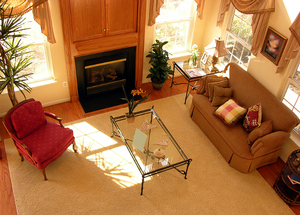Are you someone like me, who gets bored with the decor on a yearly basis, and wants to make a change? If so, neutral colored walls are the way to go. I’ll admit that stark white walls are boring, unless you’re doing a two-color scheme and one of the colors is white. Still, a neutral color with white trim gives your walls a boost without limiting your decor choices in the future. We all get bored with our furniture and accessories at some point, but we live with them for years. Why? Because we don’t want to paint the walls. I don’t mind having bedrooms or studies reflect my personality with color, but my main living areas are always neutral, because not having to match my decor to colored walls makes change so much simpler.
What are Neutral Colors?
I’ve spent a lot of time learning about neutral tones while decorating my house. My favorite neutral wall color is antique white, but there are many to choose from. In design, neutral literally means “without color,” but that isn’t completely accurate. Some designers even consider pale tones of blues and lavenders to be neutral, but I don’t agree with that. To me, a neutral color is one that doesn’t limit the colors you can use in decorating. A neutral color can be ivory, off-white, beige, tan, taupe and of course white. Believe it or not, dark brown and black are also considered neutral, as is gray. I prefer nature tones for decorating, so black and gray wouldn’t work for me, but if you like blues, gray-toned colors or the pink-mauve palette, gray would work very well.
Color Undertones Make a Huge Difference
Understanding undertones is crucial to choosing the best wall color. White isn’t always white, and that goes for all the other neutral colors as well. There are gray-whites, yellow-whites, brown-whites and white-whites. There is even a ceiling white, which is really an off-white to reduce glare. Tan and beige can have gray or yellow undertones. Any woman who wears mascara knows that there is black, and there is soft black and then there is brown-black or black-brown. Be careful of choosing the neutral with the right undertones to accent your chosen furniture and accessory colors. For example, antique white has warm yellow undertones, so I would likely decorate with brighter colors than if the walls were gray-white. Still, I could go with more subtle colors that had a yellow undertone, such as pale peach, pale lemon yellow or pastel spring green.
Choosing the Right Trim Colors Can Make a Look Pop
You need to think seriously about the trim color. I love bright white trim, but some would rather unify the room by having the same color throughout. If your house has an open floor plan, you need to have the same trim color in all visible rooms. In fact, there are rules for choosing trim colors, but for neutrals, off-white or bright white always works well. Trim should never be in too stark a contrast to the walls, for example, if you’re going with a dark tan wall color, bright white trim will be too glaring. A color a few shades lighter or an off-white will work much better. In fact, one expert I talked with suggested a quarter- or half-tone of the darker wall color as a trim color.
Choosing paint colors is always a chore. Using neutrals makes it just a little less daunting, and allows you to paint less often, which is something every homeowner will appreciate. An added bonus is that you can change the entire look of a room in a day by using different accessories or furniture covers, so paint those walls neutral and fulfill your wildest decorating fantasies!





